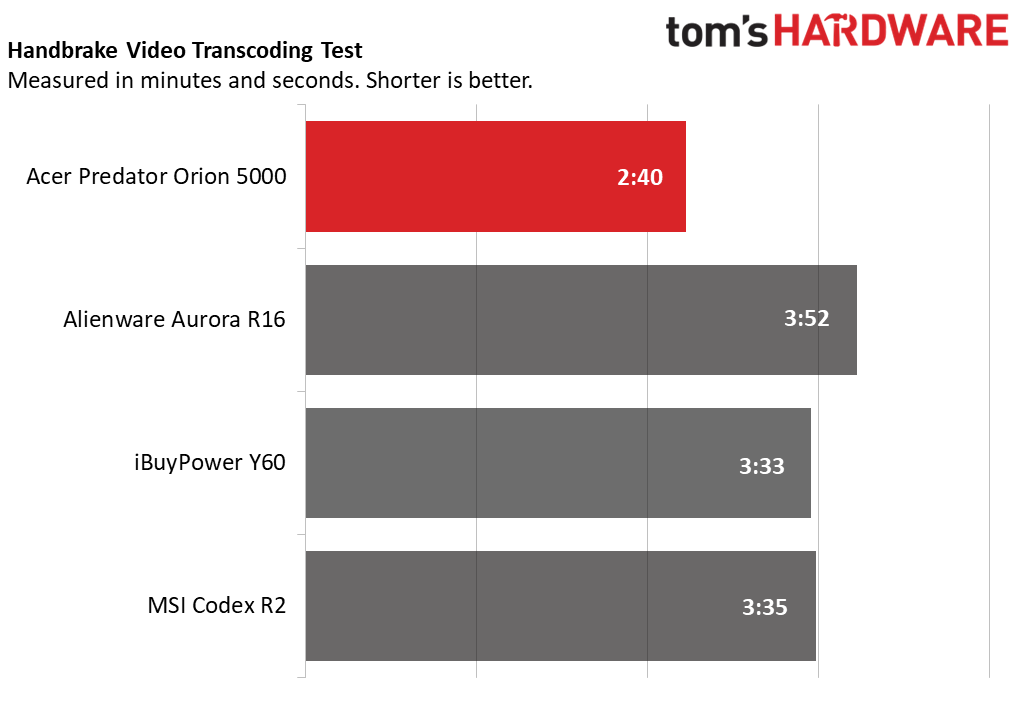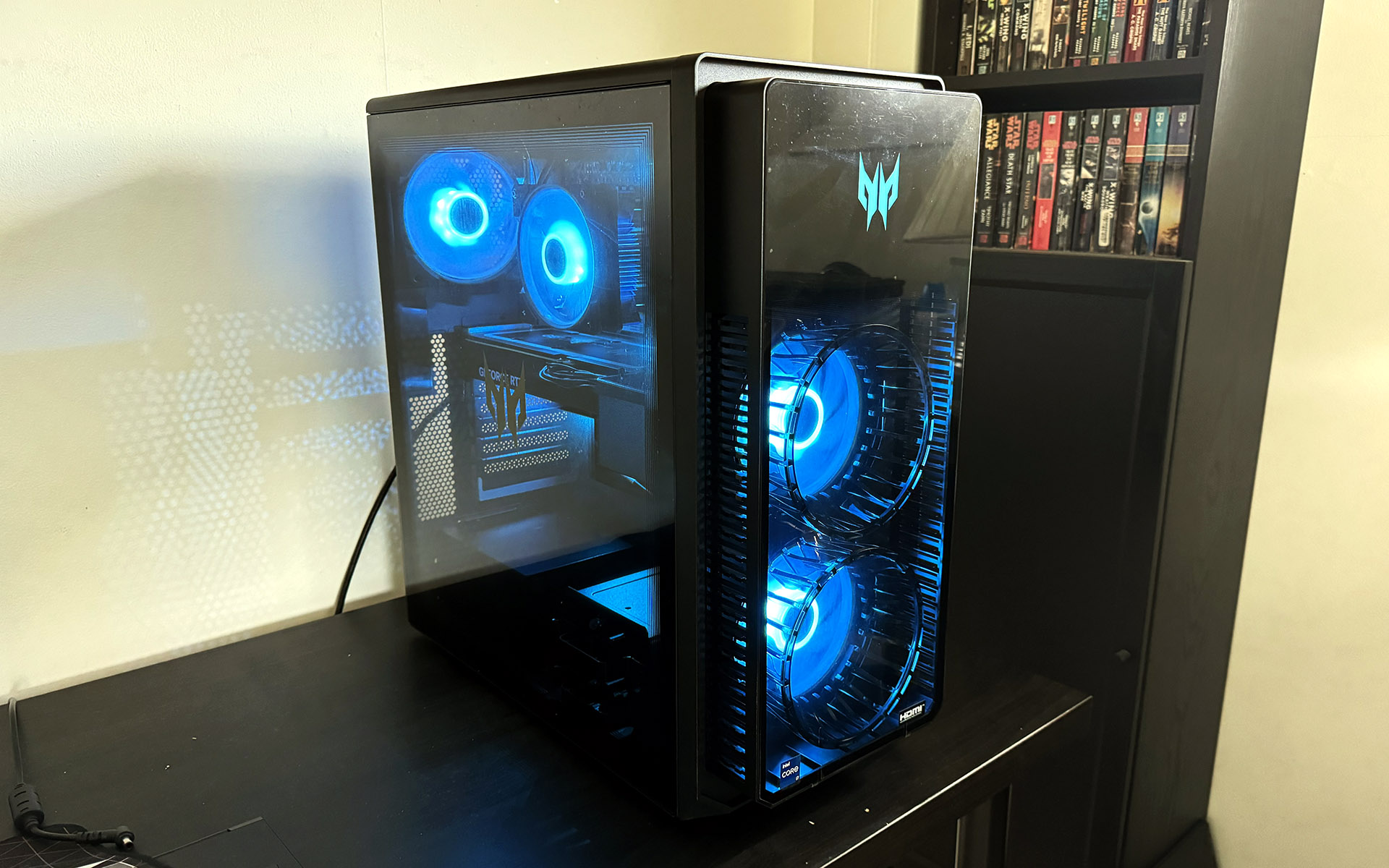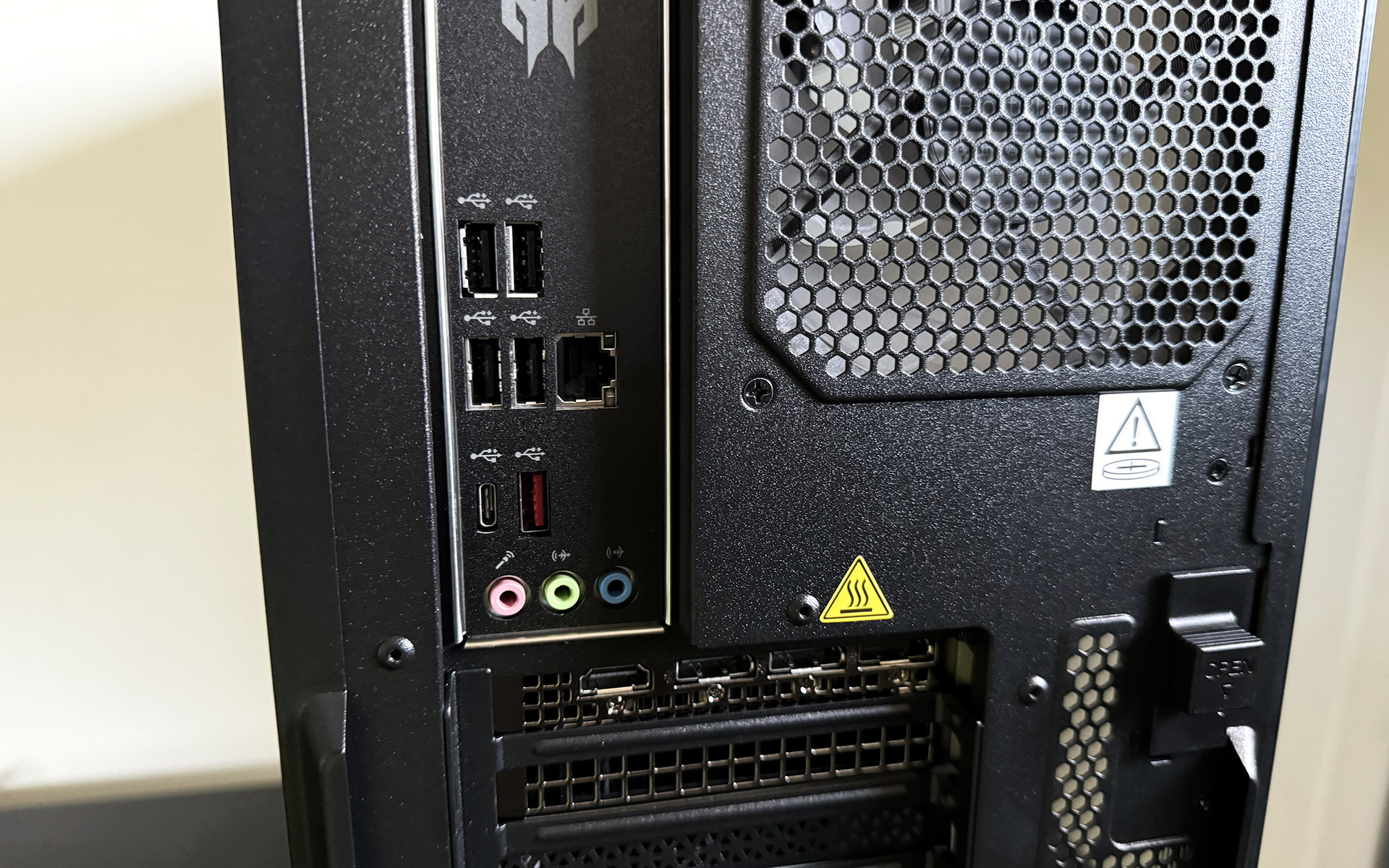Tom's Hardware Verdict
The Predator Orion 5000 delivers excellent performance for the money, with a Core i7 and a GeForce RTX 4070 Super for about $1,500, though its looks and case aren’t as upscale as some competing PCs.
Pros
- +
Solid gaming performance from Core i7 and RTX 4070 Super
- +
Well priced for a pre-built tower
- +
Plenty of ports, including 20 Gbps USB-C
Cons
- -
Average case quality
- -
Noticeable fan noise while gaming
Why you can trust Tom's Hardware
The Acer Predator Orion 5000 mid-range gaming desktop aims to maximize value. Though its case isn’t the most upscale we’ve seen, it offers user-configurable lighting and plenty of ports, connections, and upgrade possibilities. Its real selling point is its impressive performance for the money, offering a powerful Intel Core i7-14700F and an Nvidia GeForce RTX 4070 Super for $1,499 as tested. That’s hard to beat.
Design of the Acer Predator Orion 5000
Acer clearly isn’t following the trend of producing more professional-looking gaming desktops. The Predator Orion 5000’s see-through front panel, RGB-lit fans, and interior LEDs make it visible a mile away and easily recognizable as a gaming machine.
At least Acer didn’t use any outlandish curves in the case design, mostly sticking to conventional lines. The front protrusion for the 120 mm fans in turbine-like enclosures is unconventional, though, and it’s my least favorite part of the desktop. The fan enclosures look cheap, and the backlit Predator logo doesn’t help matters.
Acer also could have done a better job with the internal lighting. The two 120 mm RGB fans look fine, but the banks of LEDs embedded in the motherboard are piercingly bright at their maximum brightness and difficult to look at. (I reduced them to their minimum brightness in the PredatorSense software for everyday use.) Interior lightstrips that are hidden from view would have illuminated the interior more evenly.
The case itself is of similar quality to a cheap case you could buy on your own case, with rolled steel making up most of the structure and plastic top and front panels. The left door is tempered glass but the front panel is plastic, which doesn’t feel upscale. Another possible cost-cutting measure is the use of CPU air cooling instead of liquid cooling, though we saw no negative performance ramifications from this as we’ll see later in the review.
Speaking of cooling, airflow perforations on the top panel and around the front protrusion do little to stop fan noise, which is noticeable when the desktop is running full-tilt. Much of the fan noise may have to do with the low-profile cooler, a similar issue to what we saw when we reviewed the At least it’s basically silent at idle, though.
Size-wise, at 8.62 x 18.98 x 19.09 inches, the Predator is larger than the Alienware Aurora R16 (7.76 x 18.05 x 16.5 inches) and the MSI Codex R2 (8.1 x 19.1 x 16.1 inches) but still within mid-tower territory.
Get Tom's Hardware's best news and in-depth reviews, straight to your inbox.
Acer Predator Orion 5000 Specifications
| CPU | Intel Core i7-14700F |
| Motherboard | Acer Predator PO5-655 (Intel H770) |
| Memory | 32GB DDR5-4800 (2x 16GB) |
| Graphics | Nvidia GeForce RTX 4070 Super (12GB GDDR6X, 2,475 MHz boost clock) |
| Storage | 1TB PCIe 4.0 SSD (HFS001TEJ9X110N) |
| Networking | Killer E3100 2.5 Gbps Ethernet, Wi-Fi 6E + Bluetooth 5.3 (Intel AX211) |
| Front Ports | USB 3.2 Gen 1 Type-C, 3x USB 3.2 Gen 1 Type-A, 3.5 mm microphone, 3.5 mm universal |
| Rear Ports | USB 3.2 Gen 2x2 Type-C, USB 3.2 Gen 2 Type-A, 4x USB 2.0, 3x 3.5 mm audio jacks (line-in, line-out, microphone) |
| Power Supply | 800 watts |
| Cooling | 120 mm air cooling, 3x 120 mm case fans |
| Operating System | Windows 11 Home |
| Dimensions (WxDxH) | 19.09 x 18.98 x 8.62 inches |
| Price (as configured) | $1,499.99 |
Ports and Upgradeability on the Acer Predator Orion 5000
The Predator’s port selection starts on the top of the front panel with one USB Type-C port, three USB Type-A ports, and 3.5 mm microphone and universal audio jacks. All the USB ports here are USB 3.2 Gen 1 (5 Gbps). These locations work well if the desktop is on the floor but less so if it’s on top of your desk since the cables from anything plugged in will cascade down.
Meanwhile, rear ports include an ultra-fast USB 3.2 Gen 2x2 Type-C port (20 Gbps), one USB Type-A port (10 Gbps), four legacy USB 2.0 ports, and three 3.5 mm audio jacks (line-in, line-out, and microphone).
A Phillips-head screwdriver is required to get inside the Predator since the side panel doesn’t use thumbscrews. The mATX motherboard has four DDR5 DIMM slots and two M.2 2280 SSD slots. The spare SSD slot oddly runs off the right of the motherboard. There’s also an M.2 2230 wireless card slot populated with an Intel AX211 card supporting Wi-Fi 6E and Bluetooth 5.3. Its antennas are built into the chassis rather than sticking out the back.
More storage can be added via two 3.5-inch bays next to the power supply. The latter has a slide-out dust filter under the chassis.
Removing the other side panel also reveals two 2.5-inch drive slots on the back of the motherboard. This side also shows the somewhat sloppy cable management.
Gaming and Graphics on the Acer Predator Orion 5000
Our Acer Predator Orion 5000 has an Intel Core i7-14700F processor (20 cores), an Nvidia GeForce RTX 4070 Super (12GB GDDR6X, 2,475 MHz boost clock), and 32GB of RAM (two 16GB sticks of DDR5-4800 running in dual-channel mode). While some 14th Gen Intel processors are having trouble with instability at high voltages, the company is expected to have a fix in August, but if you're concerned you may want to hold off.
Playing Cyberpunk 2077 at 3840 x 2160 at the Ray Tracing Ultra preset with DLSS frame generation, I saw a 75-85 fps indoors and low-90 fps outdoors. It was highly playable and I didn’t notice any lagging or performance spikes.
We’re comparing the Predator to three other gaming desktops, including the Alienware Aurora R16 (Core i7-14700F, RTX 4070), the iBuyPower Y60 Gaming Desktop (Ryzen 7 7700X, RTX 4060 Ti), and the MSI Codex R2 (Core i7-14700F, RTX 4060 Ti). The Alienware is the most comparable since it has the next-fastest GPU; the others will likely not be that competitive considering they use a GeForce RTX 4060 Ti, but they're in a similar price range.





In Shadow of the Tomb Raider (Highest detail preset), the Predator easily took the top spots, with 179 fps at 1080p and 63 fps at 4K next to the Alienware’s respective 161 fps and 54 fps, suggesting the Predator’s RTX 4070 Super is quite a bit stronger than the RTX 4070 non-Super. The iBuyPower and MSI desktops were nowhere close, though we expected that considering they again use a GeForce RTX 4060 Ti.
Cyberpunk 2077 (Ray Tracing Ultra) saw the Predator producing 71 fps at 1080p and an unplayable 20 fps at 4K. We don’t have results for the Alienware here, but the next-closest MSI Codex R2 was far back, with 47 fps at 1080p. Neither the MSI nor the iBuyPower cleared single-digit fps at 4K.
Next, Far Cry 6 (Ultra) proved CPU limited at 1080p, with all desktops scoring within about 10 fps, though the Predator took a clear lead at 4K with 73 fps compared to the Alienware’s 63 fps and the iBuyPower’s 47 fps.
Red Dead Redemption 2 (Medium) was another win for the Predator, where it produced 128 fps at 1080p and dropped to 39 fps at 4K. The Alienware was well behind, with 108 fps and 32 fps respectively, and naturally the iBuyPower and MSI trailed because of their lesser GPUs.
Finally, the Predator had another landslide win in Borderlands 3 (at the game’s “Badass” detail preset), with 174 fps at 1080p and 64 fps at 4K. The Alienware wasn’t even close (144 fps and 52 fps, respectively) and both the iBuyPower and MSI had the same numbers (115 fps and 36 fps, respectively).
Overall, the Predator demonstrated remarkably better performance than the Alienware, most of which comes from it using an RTX 4070 Super and not an older RTX 4070. It also has a theoretically faster CPU (Core i7-14700F versus Core i7-13700F) with extra cores.
We also run the Metro Exodus stress test to simulate half an hour of gameplay. During the test, the Core i7-14700F ran at an average frequency of 4.2 GHz on the P-cores and 3.5 GHz on the E-cores. The P-cores averaged 59 degrees C while the E-cores were 59 C. Meanwhile, the GeForce RTX 4070 Super had an average clock of 2.6 GHz and ran at 73 C. The Predator averaged 114 fps across all runs.
Productivity Performance on the Acer Predator Orion 5000
We tested the Predator Orion 5000 with an Intel Core i7-14700F processor, 32GB of RAM, and a 1TB SSD. This is a balanced system for almost any kind of usage, including content creation, though the storage drive may fill up quickly with too many games or unedited videos.
The Predator scored mid-pack in the Geekbench 6 synthetic CPU benchmark, with 16,534 points in multi-core to almost tie the Alienware (16,687 points) and outperform the iBuyPower (15,261 points), although it couldn’t quite catch the MSI (17,818 points). It was also second to last in the single-core scores with 2,643 points where the iBuyPower took top honors, with 2,991 points.



Our handbrake test transcodes a 4K video to 1080p, which the Predator completed in the quickest time of 2 minutes and 40 seconds. All the other units took more than three minutes, with the iBuyPower being the fastest (3:33) and the Alienware the slowest (3:52).
We also run our 25GB file transfer test on the system’s main storage drives. The Predator was faster than the others, with 1,585 MBps average to 1,328 MBps for the next-fastest iBuyPower. The MSI was the only unit not to clear the 1,000 MBps mark, with just a 978 MBps average.
Keyboard and Mouse with the Acer Predator Orion 5000
The keyboard and mouse included with the Predator Orion 5000 are basic wired peripherals. The low-profile keyboard has a brushed finish for a little flare and a large back foot to angle it towards you. The keys have a plastic and rather lifeless feel and no backlighting.
The mouse is a similar story, with minimal functionality from its two buttons and scroll wheel. It fits in my medium-size hand without problems. The optical sensor seemed accurate on my mousepad and bare desk surface.
Overall, the peripherals are functional but lacking for extra features. Check out our best keyboards or best mice for real upgrades.
Software and Warranty
Acer’s familiar PredatorSense is the most important included app. Controls inside include fan profiles and lighting. I found the lighting controls especially important for turning off the overly bright motherboard LEDs I mentioned earlier.
Acer has changed this app for the better since I last tried it; now, you can combine multiple settings (fans, lighting, and so on) into a single profile and easily switch between them. PredatorSense also has an app center where you can launch any app on your PC and create shortcuts. The real value is that you can link an app to a profile, so those settings are automatically applied when the app is launched. For instance, a specific lighting profile could engage when you launch a certain game.
There are unfortunately several less useful apps installed including Acer Product Registration, Acer Jumpstart (which merely opens the Acer store in a web browser – really?), and several trial apps including Express VPN and Dropbox.
Acer backs the Predator Orion 5000 with a one-year warranty.
Acer Predator Orion 5000 Configurations
We tested the Acer Predator Orion 5000 in its PO5-655-UB21 SKU with a Core i7-14700F processor, a GeForce RTX 4070 Super GPU, 32GB of RAM, and a 1TB SSD. It retails for $1,749 but was on sale at Best Buy for $1,499 at the time of this review.
Best Buy also offers model PO5-655-UB22 for $2,099, which ups the graphics card to a GeForce RTX 4070 Ti Super and doubles the storage to 2TB. I didn’t find any other configurations for sale.
A comparable Alienware Aurora R16 was $1,799 with the same basic loadout but a 2TB SSD. I also saw a variant of the iBuyPower Y60 Gaming Desktop at Best Buy for $1,449.99 albeit it only delivered a non-Super RTX 4070 for that price. Overall, Acer has competitively priced the Predator Orion 5000.
Bottom Line
The prebuilt gaming desktop market is tough to compete in, but Acer’s Predator Orion 5000 earns a spot as one of the better values. For $1,499 as reviewed, it delivers a Core i7-14700F and a GeForce RTX 4070 Super for several hundred less than an Alienware Aurora R16. It has plenty of performance for mild 4K gaming and is overkill for 1080p.
This desktop’s downsides include merely average case quality, with lots of plastic and lighting that could be more elegant. It also uses CPU air cooling instead of a sealed liquid unit, though that didn’t seem to hurt its performance. For better case quality, the iBuyPower Y60 Gaming Desktop is miles ahead, though it doesn’t have as good of price to performance comparisons. Overall, the Predator Orion 5000 provides excellent value and earns our recommendation for a mid-range gaming desktop.
MORE: Best Gaming PCs
MORE: Best PC Builds
MORE: Best Gaming Laptops

Charles Jefferies is a freelance reviewer for Tom’s Hardware US. He covers laptop and desktop PCs, especially gaming models.







